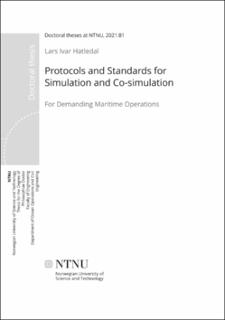| dc.contributor.advisor | Zhang, Houxiang | |
| dc.contributor.advisor | Hovland, Geir | |
| dc.contributor.advisor | Styve, Arne | |
| dc.contributor.author | Hatledal, Lars Ivar | |
| dc.date.accessioned | 2021-05-12T09:55:01Z | |
| dc.date.available | 2021-05-12T09:55:01Z | |
| dc.date.issued | 2021 | |
| dc.identifier.isbn | 978-82-326-5231-0 | |
| dc.identifier.issn | 2703-8084 | |
| dc.identifier.uri | https://hdl.handle.net/11250/2755142 | |
| dc.description.abstract | There is a strong demand for innovation and efficiency within operations, life cycle services, and design of maritime systems. Modern vessels operate increasingly autonomously through strongly interacting sub-systems. These systems are dedicated to a specific, primary objective of the vessel or may be part of the general essential ship operations. The sub-systems exchange data and make coordinated operational decisions, ideally without any user interaction. The task of designing, operating, and integrating life cycle services for such vessels is a complex engineering task that requires an efficient development approach, which must consider the mutual interaction between the inherent multi-disciplinary on-board sub-systems. Digitalization thus has become a key aspect of making the maritime industry more innovative, efficient, and fit for future operations.
However, no one simulation tool is suitable for all purposes and the plethora of modeling tools within different disciplines exists for very good reasons. Issues related to integration of heterogeneous systems and hardware, memory, and CPU utilization makes implementing complex-cyber-physical systems, like vessels, in a monolithic or centralized manner undesirable.
Co-simulation alleviates this issue, allowing different sub-systems to be modeled independently, but simulated together. Co-simulation refers to an enabling technique, where different sub-systems making up a global simulation are being modeled and run in a distributed fashion. Each sub-system is a simulator and is broadly defined as a black box capable of exhibiting behavior, consuming inputs, and producing outputs. A crucial point is that it allows users to simulate models exported from different tools in a unified manner. Compared to more traditional monolithic simulations, co-simulation encourages re-usability, model sharing, and fusion of simulation domains.
Co-simulation can be expanded into the realm of digital twins by feeding sensor data measured from the real world into the models, which in turn closes the loop by providing actionable feedback. A digital twin can be defined as a virtual representation of a physical asset enabled through data and simulators for real-time prediction, optimization, monitoring, controlling, and improved decision making. As the digital twin mimics its physical counterpart, it can be used to estimate a vessels performance before running any tests in the real world. This not only offers flexibility, but also cuts down costs to a great extent. These proxies of the physical world will help companies in the maritime industry in developing enhancements to existing products, operations, and services, and can even help drive business innovation.
This dissertation aims to drive adoption of co-simulation standards and development of use-cases by providing software that makes co-simulation simpler and more intuitive. This includes enabling technology for building standard-conforming models and systems, and subsequent tools for simulating them. The case studies presented show the effectiveness of the proposed approach. | en_US |
| dc.language.iso | eng | en_US |
| dc.publisher | NTNU | en_US |
| dc.relation.ispartofseries | Doctoral theses at NTNU;2021:81 | |
| dc.relation.haspart | Paper 1:
Hatledal, Lars Ivar; Zhang, Houxiang; Styve, Arne; Hovland, Geir.
“FMI4j: A Software Package for working with Functional Mock-up Units on the Java Virtual Machine”, The 59th Conference on Simulation and Modelling (SIMS 59), vol. 153, no. 6, pp. 37–42, 2018. http://dx.doi.org/10.3384/ecp1815337 | en_US |
| dc.relation.haspart | Paper 2: L. I. Hatledal, H. Zhang, A. Styve, and G. Hovland, “FMU-proxy: A Framework for Distributed Access to Functional Mock-up Units”, Proceedings of the 13th International Modelica Conference, vol. 183, pp. 240–251, 2019.
http://dx.doi.org/10.3384/ecp1915779 | en_US |
| dc.relation.haspart | Paper 3: L. I. Hatledal, A. Styve, G. Hovland, and H. Zhang, “A Language and Platform Independent Co-simulation Framework Based on the Functional Mock-up Interface”, IEEE Access, vol. 7, pp. 109328-109339, 2019.
https://doi.org/10.1109/ACCESS.2019.2933275
This work is licensed under a Creative Commons Attribution 4.0 License. | en_US |
| dc.relation.haspart | Paper 4:
L. I. Hatledal, F. Collonval, and H. Zhang, “Enabling Python Driven Co-Simulation Models with PythonFMU”, Proceedings of the 34th International ECMS-Conference on Modelling and Simulation-ECMS 2020}, vol. 34, no. 1, 2020.
https://doi.org/10.7148/2020-0235 | en_US |
| dc.relation.haspart | Paper 5:
Hatledal, Lars Ivar; Skulstad, Robert; Li, Guoyuan; Styve, Arne; Zhang, Houxiang.
“Co-simulation as a Fundamental Technology for Twin Ships”, in Modelling Identification and Control, vol. 41, no. 4, pp. 297-311, 2020.
https://doi.org/10.4173/mic.2020.4.2
This is an open access article under the CC BY 3.0 license | en_US |
| dc.relation.haspart | Paper 6: Hatledal, Lars Ivar; Chu, Yingguang; Styve, Arne; Zhang, Houxiang.
“Vico: An Entity-Component-System Based Co-simulation Framework”, Simulation Modelling Practice and Theory, vol. 108, April 2021.
https://doi.org/10.1016/j.simpat.2020.102243
This is an open access article under the CC BY 4.0 license | en_US |
| dc.title | Protocols and Standard for Simulation Co-Simulation – For demanding maritime operations | en_US |
| dc.type | Doctoral thesis | en_US |
